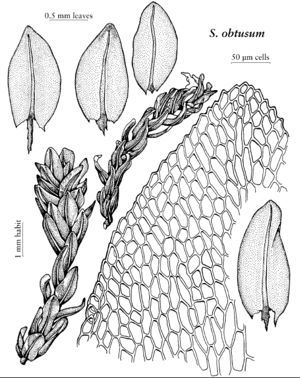Difference between revisions of "Splachnobryaceae"
FNA>Volume Importer |
FNA>Volume Importer |
||
| Line 45: | Line 45: | ||
|publication year= | |publication year= | ||
|special status= | |special status= | ||
| − | |source xml=https://jpend@bitbucket.org/aafc-mbb/fna-data-curation.git/src/ | + | |source xml=https://jpend@bitbucket.org/aafc-mbb/fna-data-curation.git/src/f6b125a955440c0872999024f038d74684f65921/coarse_grained_fna_xml/V27/V27_949.xml |
}}<!-- | }}<!-- | ||
-->[[Category:Treatment]] | -->[[Category:Treatment]] | ||
Revision as of 19:41, 24 September 2019
Plants acrocarpous. Stems mostly simple; in section showing a few layers of large cells with slightly thickened walls surrounding a few layers of cells with thinner walls, both layers chlorophyllose and with yellowish walls; at the center a field of thin-walled cells with a central strand undifferentiated to present and distinct, the medial cells of the stem sometimes disintegrating and leaving a void; axillary hairs 2–3-celled, proximal cell(s) short, with faintly yellowish walls, distal cell much larger. Leaves oblong to obovate-spatulate, rarely bordered with elongate cells; costa single, sometimes with short lateral spurs or forked, in cross section showing 0–2 guide cells and 1–5 substereid cells; medial cells of leaves oblong, smooth or occasionally distinctly mammillose on one or both surfaces. Specialized asexual reproduction by gemmae on axillary rhizoids and by rhizoid tubers. Sexual condition dioicous; perigonia terminal, becoming lateral by innovations, antheridia sometimes solitary in leaf axils proximal to the perigonial; perichaetia absent, archegonia clustered at stem tip, becoming solitary in leaf axils by elongation of stem apex, paraphyses absent. Seta single, short, smooth. Capsule exserted, erect, symmetric; annulus of several rows of thick-walled isodiametric to horizontally elongate cells; operculum conic-apiculate; peristome a single circle of 16 teeth. Calyptra elongate, narrowly conic-cylindric, split from base on one side about half its length. Spores spheric, yellowish.
Distribution
Tropical and subtropical regions of the world.
Discussion
Genus 1, species ca. 23 (1 in the flora).
Splachnobryum has been regarded as the sole genus of the family Splachnobryaceae (A. Koponen 1981). Previously the genus was placed in the Pottiaceae or in the Splachnaceae. The axillary archegonia, absence of paraphyses, single circle of peristome teeth (considered to represent the endostome by Koponen), and the peculiar axillary hairs (mucilage hairs in the sense of Koponen) help define the family. The latter are sometimes difficult to demonstrate; they are helpful in identification of sterile specimens. Somewhat similar axillary hairs also occur in the Pottiaceae, in Globulinella globifera (G. E. L. Hampe) W. C. Steere, except that in the latter the terminal cell is clavate and symmetric instead of swollen and asymmetric
